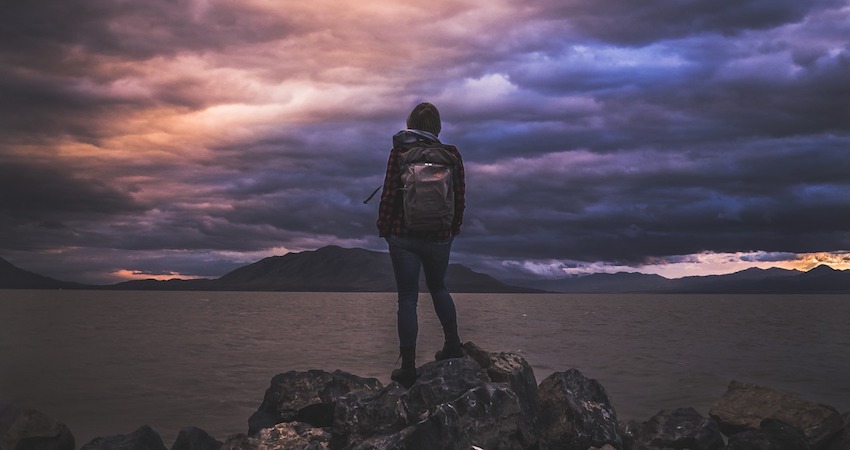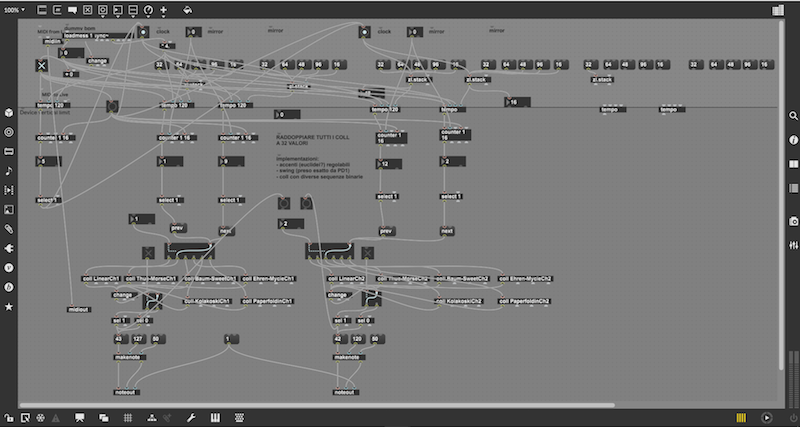The Adventurers of August: A Quick Look Back at the Artists Looking Forward

Whether you’re preparing for crunching leaves or budding flowers, the end of August offers a chance for reflection on the changing of the seasons, on what great journeys have been made, and at what is coming next. In August, we published some fascinating projects by old friends and new faces from all over the world, but just who are these adventurers as artists; as professionals; as members of our Max community?
Thanks to their astounding generosity, we are able take you on a whirlwind world tour, peeking over the shoulder of each of our August artists at the itineraries (and the patches) that they are creating.
POLYDRIP 2
By Weightausend, GUI / visual design by Alex Ortiga
Our first stop is in Milan, Italy, with a cyber-security tester who creates Max for Live devices such as FLEX, POLYDRIP 2, HOLYPOLY, and NEXT for use in improvisatory breakbeat/jungle/dance musical production and performance under the name Weightausend.
POLYDRIP2 Improvised Demo by Weightausend
"I am truly obsessed with the idea that binary sequences and algorithms from the modern era can generate something mystically related to the process of rhythm generation."
For Weightausend, data is like water; it is an element, and the devices treat it as such, exploring the interplay between these and other natural events. For example, POLYDRIP2 generates rhythms according to the Euclidean algorithm and allows users to modify the logic as they go.

Similarly, the forthcoming HOOK will use self-similarity and binary sequences — Kolakoski and Thue-Morse — to generate syncopated rhythms that push the envelope and allow for greater, easier rhythmic creativity in Ableton Live.
Diffusion
By Chris Vik
From the flow of data to the sound of sight; have you ever wondered what an object sounds like? What art a conductors baton itself creates or about the music in a wave goodbye?
Our next visit is with Chris Vik, a Melbourne media artist and creative developer who has been working from the age of 12 to understand the many relationships between programming and music, and, more recently, how to create tactile communication between gesture and sound synthesis.
Wanting to be “inside the synthesizer,” he asks:
"What does it look like? What does it sound like? What happens when you throw or twist a sound
with your hands?"
His latest in a series of ever-advancing explorations, Diffusion, an open source particle system granular synthesizer, allows for tight control between gestural input and sonic output as well as additionally experiment through Oculus Rift or Vive HMDs; hear your movement, then, if that’s not enough for you, see your sound.
Interested? “We’ve gone from analogue to virtual over the past, about 100 years,” Chris explains, and points out that we’re at a juncture where we can map basically any thing to any thing else. With all this possibility, he is excited to see what comes next!
Particle System Granular Synthesiser (Leap Motion Controlled)
LEAP Motion Controlled Particle System Granular Synthesizer Demo by Chris Vik
Strange Attractor Synth
By Timo Hoogland
A live coder and music technologist, creator Timo Hoogland comes from the small city of Apeldoorn in the Netherlands. Also an educator at the HKU University of the Arts Utrecht, the idea for the Strange Attractor Synth, which harnesses data from chaotic algorithms such as the Lorenz Attractor for use as modulators, came to Timo as a result of a Max creative coding class he was teaching.
Yet the synth is one experiment amidst larger projects, such as his last installation, Circle of Times, or his custom live coding environment, Mercury. Using Jitter and a responsive text editor for visuals, MSP for the synthesis and sampling, and JavaScript for interpreting and parsing of the code, the environment focuses on quick expression, composition and communication of live coded electronic algorithmic music from the performer to the audience, offering greater accessibility to a broader community of viewers.
Mercury Live Coding Session by Timo Hoogland
Look for Timo at Algo Rhythms and the NLCL Algorave as well with Marieke Verbiesen, Gerri Jäger and Mark van de Heuvel on the forthcoming Loud Matter. For this project, Marieke is producing audio-reactive stop-motion animation, and Timo is programming the visual environment in Max so that the layering and effects applied to of the successive photographs reacts through midi triggers to the live playing of musicians.
Cinematica
By Rosa Francesca
From the Netherlands we fly to the UK, where we find Rosa Francesca, who is working to explore identity and extend accessibility through her artistic practice. Cinematica, a project that allows folks with physical disabilities to produce precise physical art, uses a Muse EEG headset to control an Axi-Draw machine so that participants, whatever their motor abilities, can draw and take home a tangible piece of artwork.
"The idea came to me following an interaction in an online group for adults with Tourette Syndrome
(I was diagnosed in 2018). A man had said that he was no longer able to make art as his motor tics rendered his hands too unsteady to use a pen or paintbrush. Lots of people suggested he take up digital art, but he wanted to create something physical."
With a background in acoustic music, Rosa learned Max specifically to use the EEG monitor and hopes to be able to continue to expand her accessibility work to incorporate eye tracking technology to help folks with conditions such as Locked in Syndrome.
Music Composition via Facial Recognition Demo by Rosa Francesca
Look for “Cinematica” again in 2020.
Fishing for Sound: An Interactive Installation Inspired by Acoustic Ecology
Max by Liza Seigido, Concept by Mavy Mastrovito
Graduate student Mavy Mastrovito and Professor Liza Seigido have teamed up in Florida for Fishing for Sound, a project that was born after an experience Mavy had working at a dolphin research center.
This interactive, immersive theatrical experience explores underwater noise pollution, which causes stress, sickness, and inability to communicate in the animals living near the coasts.
The next step? Mavy hopes to bring the piece to bigger audiences, perhaps by adapting the work for a museum setting.
In addition to teaching, Liza is also in the process of designing and constructing a permanent home for her immersive opera group Psyche Electro-Acoustic Opera Company, which she founded in 2016.
Selection from Missa della Grande Transizione - Directed by Liza Seigido
Max plays a major role in all the works Liza produces, as in Cyborgs Are Dancing, where a game controller manipulates audio and a swirling mapped video overlay, or in Missa della Grande Transizione, seen above, which turns the voice of only one solo vocalist into an orchestra of sound.
Noxin Music System
by João Silva
Our final August destination is in Portugal with artist João Silva, a musician and architect working with Max as a way to create music with fluidity.
What if you could produce an entire album without changing Live sets or futzing with files, but with only the aid of a single Max patch?
That’s what João has done with the Noxin Music System.

Named after the punchline of an old pager commercial where a cheating gameshow contestant reads his pager upside down and consequently botches the answer (Nixon), the name of João’s work captures something essential about his understanding of music and technology.
He says:
"That kind of “lost in translation” happens all the time to us in technology, and I feel that […] we as humans, we can never fully understand the machines. [...] Those moments are sometimes — they open possibilities between we humans and the technology."
Listen on Bandcamp to Shifting With Prisms Album by João Silva. (Look for a new album release from João this year.)
So who are our August artists? They’re students and professors; they’re programmers and advocates; they’re digital sound artists, architects, and improvisers — they’re “adventurers” from across the globe, setting out to discover new and wonderful potentials in this world — but, most importantly of all, they’re our community. And indeed, the fact that they were as artists creating something that others can build off of was a part of many of these conversations, if not directly with the patches or devices themselves, then with the creative events they lead to.
As Timo says,
"I like to inspire other people with my work or at least give something to the community to see what other people build upon it […] the [Strange Attractor Synth] is just an instrument… I’m hoping someone will make music with it."
We’re glad for this opportunity to celebrate August, and are looking forward to the music to come.
by Emily Twines on September 16, 2019

